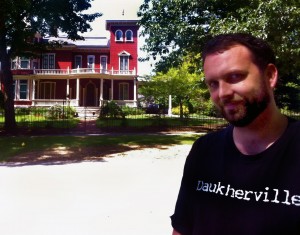It’s time for Halloween party-planning, so I figured it’s a good time to take a stroll through some of my favorite Halloween / horror film theme songs. Here goes …
13. Tales from the Crypt
Another classic theme from Danny Elfman. It was a bit of tough call which Elfman piece to go with for this article, the other strong contender being something from The Nightmare Before Christmas. Either way, no Halloween mix is complete without something from this guy.
12. The X-Files
It might’ve ended ingloriously, but this theme still recalls years of pleasant creepiness. The best episodes of The X-Files still hold up, and I’ve yet to find a good replacement for the hole left by its slow dissolution.
11. Ghostbusters
The song that became a cliche, and yet … it’s still fun, just like the movie. Of course, it’s also unintentionally hilarious in places, such as when Ray Parker, Jr. sings, “Bustin’ makes me feel good!” I mean, I’m sure it does, but c’mon, Ray, there are children here.
10. Unsolved Mysteries
Ever since I was a young kid, this theme has filled me with the uneasy sense that something terrible is at work in the world. It doesn’t hurt that the show was about awful things happening in the real world that were always left disturbingly unresolved.
9. Hellraiser
Now it’s time to start getting a bit more scary. Christopher Young’s theme sounds exactly like the kind of horrible, revelatory stuff you’d hear playing when someone opens a gateway to Hell. Perfect for any party!
8. Pennywise the Clown Theme
Ha ha ha! C’mon, everybody loves a creepy clown theme that almost sounds like it could be a jingle for an ice cream truck. And really, I might have just loved this photo of Pennywise, one of Stephen King’s finest creations. “We all float down here …”
Oh yeah.
7. 28 Days / Weeks Later
This adaptation of “East Hastings” by Godspeed You! Black Emperor is the perfect theme for an apocalyptic nightmare spinning out of control. I listen to it all the time while I write.
6. Thriller
Arguably the best music video ever made, I might sometimes think I don’t need to ever hear this song again … until it gets to the Vincent Price part.
5. Scream, “Red Right Hand”
Nick Cave and the Bad Seeds’ “Red Right Hand” was on endless repeat after I saw the first Scream film. Nick Cave is really at his best writing songs about murderers. Special points awarded to the editor who timed Deputy Dewey closing the car door to one of the dramatic musical hits in this song. Nicely done!
4. Halloween
John Carpenter not only wrote and directed a movie that spawned a franchise and gave endless fuel to the bogeyman/slasher film sub-genre, but he also created one of the single best scary movie themes ever made. This one is not only a must for a Halloween mix, it’s also probably a given.
Did I mention it’s what I programmed into my phone’s to wake me up every day?
3. Dead Man’s Bones, “My Body’s A Zombie For You”
Not technically from a movie or TV show or whatever, although it was originally planned as a kind of musical, Ryan Gosling’s odd side-project is actually amazing and perfect for Halloween. I can’t get enough of the album, and this song in particular is especially great. As if being a good-looking, talented actor wasn’t enough, Gosling has to go and make one of my favorite creepy cool albums …
2. Rosemary’s Baby
Never has a lullaby been put to such good effect. The way this theme is woven into the film through several clever variations is masterful. This is gorgeous, creepy stuff!
1. The Shining
I mean, you could try to do better than this opening music to one of the best horror films of all time.
You could try …







